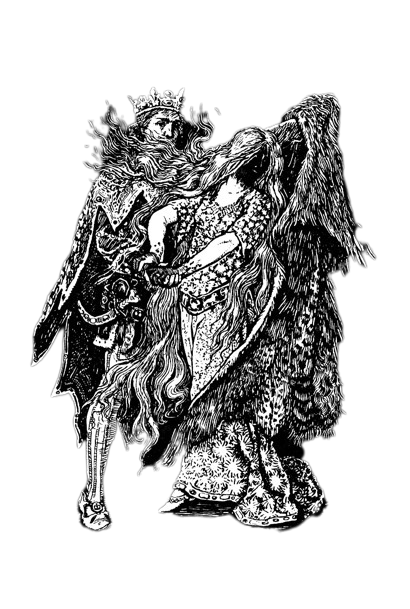Princesses, Talking Animals, & Cannibalism: Fairy Tales We All Know and Love
A fairly ubiquitous childhood experience, fairy tales have long served as a repository of delight and fascination for young children. However, through careful analysis of the source material that modern fairy tales ostensibly seek to retell, Sharon Sandler ’25 reveals the dark and even grotesque underbelly of these seemingly innocent stories. Through thick and thin — that is, disturbing and even more disturbing — Sharon braves the depths of the Brothers Grimm’s twisted tales, tracing their problematic ties to violence, incest, cannibalism, misogyny, and even the rise of Nazism.
RYAN GOODMAN // FLAT HAT MAGAZINE
What makes a fairy tale a fairy tale?
Is it the princess? The enchanted animal? Or perhaps the incestuous father and cannibalistic stepmother?
To understand fairy tales, we must first understand their origins. Fairy tales fall under the field of folk studies, and a disputed — but key — idea in folk studies is that there is no single “original” version. In other words, the fairy tales we know today are just the popularized, highly edited versions of stories from an endless sea of diverse, unrecoverable, orally transmitted variations. The popular Brothers Grimm were not authors but story collectors, and originally, their collections were not even intended for children — their goal was to preserve cultural history, and only a combination of dwindling prospects in academia and nationalistic ideas sweeping German lands would lead to the collection’s introduction into schools. The brothers’ editing practices strongly influenced the stories preserved today — because the brothers disapproved of premarital sex, for example, mentions of premarital sex were edited out of many of their tales. However, violence, incest, sexism, and cannibalism were, perhaps surprisingly for a modern audience, not on the brothers’ list of discomforts.
COURTESY IMAGE // QUORA
Disney’s adaptation of “Cinderella” is far from the tale the Brothers Grimm recorded in their 1812 and 1857 collections — theirs is replete with violence, gore, and female mutilation. In the Grimms’ version, there is no godmother or carriage. Instead, Cinderella sleeps in ashes, weeps, and prays for three days until animals come and help her attend the ball. When the prince eventually tries to uncover her identity, he traps her in a path filled with a sticky, tar-like substance and then sends his guards to find her — stalking and physically restraining a woman are “charming” acts that will get you the girl.
After Cinderella’s stepsisters unsuccessfully cut off their heels or toes to take her place, Cinderella proves her true identity by sliding her foot easily into the slipper (without, of course, leaving behind blood like her stepsisters). Nor are the loss of toes and heels sufficient punishment for these women — pigeons peck out their eyes at Cinderella’s wedding, the happy ending. The Brothers Grimm’s Cinderella is a tale of repeated female suffering laced with violence and gore. But there is still a princess, enchanted animals, and what is supposed to be a happy ending. There are no internal thoughts — everything is on the surface, and that surface is bloody.
COURTESY IMAGE // WIKIMEDIA
To find the incestuous father, we look to “Allfurs,” also known as “All-Kinds-of-Furs” or “Allerleirauh.” The queen, on her deathbed, told her husband that if he chose to remarry, the woman must be as perfect as her, and the king decides that their daughter is the only woman who meets this standard. The daughter is forced to disguise herself as a feathered creature to escape her father’s desire and ends up having to work as a servant for another king, whom she falls in love with and eventually convinces to be her beloved.
Upping the disturbing material to evil stepmothers, murder, and cannibalism, we look to “The Juniper Tree.” A man and his wife essentially conceive a son from a tree outside of their house, but the wife dies as soon as the child is born, and the husband eventually remarries and has a daughter, Marlene, with his new wife. The new wife is a “gold digger,” and to make sure nothing will come in the way of her inheritance, she chops off the head of her husband’s son, then puts the head back on his neck to disguise her crime, all while placing an apple in his hand. When Marlene enters the room and asks her half-brother for the apple (unaware of the situation), he, of course, does not respond, and Marlene’s mother instructs her to ask for the apple again and to hit her half-brother in the ear if he doesn’t respond, which, of course, causes his head to fall to the floor. The wife then cooks the son and feeds him to her unsuspecting husband and daughter, who believes she killed her half-brother by hitting him. Marlene cries and buries his bones under the juniper tree. The tree produces a bird that sings an eerie song and goes on a journey to retrieve a golden chain, red shoes, and a millstone. The bird returns to the juniper tree, gives the father the golden chain and Marlene the red shoes, and kills the wife with the millstone before miraculously transforming into the son. The happily reunited family goes inside and enjoys a joyous meal together.
There is no shortage of unsettling elements in “The Juniper Tree.” Like in “Cinderella” and “Allfurs,” good things follow female suffering, but more importantly, the addition of the evil stepmother reaffirms a misogynistic narrative intertwining murder and cannibalism. Yet, like other fairy tales, the story lacks depth, character development, and explanation. This lack of surprise and questioning by the characters when experiencing and witnessing horrible things helps create the unnerving tone of fairy tales. Our discomfort with fairy tales is further amplified when looking beyond the actual content of the tales to how they helped advance the Nazi party. Amid the rise of German nationalism, the Nazis turned to fairy tales as a source of socialist realism, which they used to create nostalgia for Germany’s “pure” and “innocent” past. Popular fairy tales like “Cinderella” were employed to showcase the “good German girl,” while other tales like “The Jew in the Thorn Bush” (also in the Brothers Grimm’s collection) manifestly promoted antisemitism. However, like the characters in the tales, German citizens seemed not to question the horrors happening around them. Nor should this parallel be interpreted as merely coincidental — folktales both are shaped by and shape contemporary society.
So, what makes a fairy tale a fairy tale?
Perhaps it is their strange connection to reality, despite their supposed distance from it.



